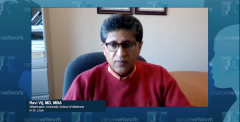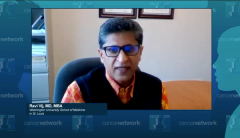
Expert Offers Considerations For Frontline Combination Therapies in Multiple Myeloma
Ravi Vij, MD, MBA, offered additional information about the use of various regimens aimed to treat patients with high-risk, newly diagnosed multiple myeloma, that were read out at the 2022 ASH Annual Meeting.
Episodes in this series

As part of CancerNetwork’s Face-Off video series, Ravi Vij, MD, MBA, professor, Department of Medicine, Oncology Division, Bone Marrow Transplantation & Leukemia at Washington University School of Medicine in St. Louis, discussed additional trials in multiple myeloma that were presented at the 2022 ASH Annual Meeting.
Vij: So, at the ASH Faceoff, my colleagues, Dr. Schroeder and Dr. Slade defended abstracts assigned to them. And Dr. Schroeder talked about an abstract looking at carfilzomib (Kyprolis), lenalidomide (Revlimid), dexamethasone and comparing it to bortezomib (Velcade), lenalidomide, and dexamethasone. This was a retrospective review at a single center, patients were treated at Memorial Sloan Kettering between 2015 and 2019. These patients had high-risk disease. And what the retrospective review seemed to suggest was that the use of Kyprolis, Revlimid, and dexamethasone was associated with a trend towards better outcomes.
This was not a randomized study, it was not a prospective study. And we have data from other trials that are somewhat contradictory in the past, including the ENDURANCE study. So I think that from this abstract, we can't gain too much to inform changing our practice, I think, for frontline use in select patients, KRd may still be considered on a case-by-case basis, but the use of VRd-based triplets and now, actually, daratumumab (Darzalex) with VRd is an increasingly common option for these patients.
The next study that was discussed by my colleague, Dr. Slade was the GMMG-Concept study. This was an abstract presented at the American Society of Hematology meeting, that was an interim analysis of the MRD status of patients in the GMMG-Concept study for transplant-eligible and -ineligible patients that were enrolled. And after a period of 6 cycles of induction, transplant eligible patients went on to transplant followed by [isatuximab (Sarclisa), carfilzomib, lenalidomide, and dexamethasone] for 4 cycles. Those that do not go to transplant got a total of 12 [cycles] of isatuximab, carfilzomib, lenalidomide, and dexamethasone. The analysis was looking at patients after the total of the 12 cycles of induction for the transplant ineligible, and the 4 cycles of consolidation for those who are transplant eligible.
And what was seen was a very high rate of MRD negativity with transplant-eligible patients achieving 68%, and those that did not get a transplant achieved 54% in this high-risk population. So this study is certainly exciting. I think that in the future, we may be able to use an isatuximab-based regimen in the frontline. There are other trials that are looking at this issue. And hopefully, that will inform decision-making in the future. In addition to the use of daratumumab, isatuximab, too, could be considered whether it is combined with Velcade, Revlimid, and dexamethasone or with Kyrprolis, Revlimid, and dexamethasone remains an open question.
Transcription edited for clarity.
Newsletter
Stay up to date on recent advances in the multidisciplinary approach to cancer.





















































































